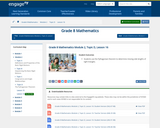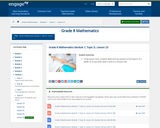
For this activity, students use the Pythagorean theorem to solve problems.
- Subject:
- Mathematics
- Material Type:
- Activity/Lab
- Provider:
- YummyMath
- Date Added:
- 04/27/2017

For this activity, students use the Pythagorean theorem to solve problems.

Students learn about radar imaging and its various military and civilian applications that include recognition and detection of human-made targets, and the monitoring of space, deforestation and oil spills. They learn how the concepts of similarity and scaling are used in radar imaging to create three-dimensional models of various targets. Students apply the critical attributes of similar figures to create scale models of a radar imaging scenario using infrared range sensors (to emulate radar functions) and toy airplanes (to emulate targets). They use technology tools to measure angles and distances, and relate the concept of similar figures to real-world applications.

For this lesson, students know that the Pythagorean Theorem can be interpreted as a statement about the areas of similar geometric figures constructed on the sides of a right triangle. Students explain a proof of the Pythagorean Theorem.

This lesson unit is intended to help teachers assess how well students are able to: use the area of right triangles to deduce the areas of other shapes; use dissection methods for finding areas; organize an investigation systematically and collect data; deduce a generalizable method for finding lengths and areas (The Pythagorean Theorem.)

In this unit students will:-Understand Pythagorean Theorem-Use Converse of Pythagorean Theorem to prove if a triangle is a right triange-Use Pythagorean Theorem to find distance between two points on a coordinate plane-Use Pythagorean Theorem to solve real world problem situations

In this lesson, students use the Pythagorean theorem to determine missing side lengths of right triangles.

In this lesson, students know that a Pythagorean triple can be obtained by multiplying any known triple by a common whole number. Students use this method to generate Pythagorean triples. Students use a system of equations to find three numbers, a, b, and c, so that a2 + b2 = c2.

This course was created by the Rethink Education Content Development Team in partnership with the North Carolina Virtual Public Schools. This course is aligned to the NC Standards for 8th Grade Math.

This course was created by the Rethink Education Content Development Team in partnership with the North Carolina Virtual Public Schools. This course is aligned to the NC Standards for 8th Grade Math.

This course was created by the Rethink Education Content Development Team in partnership with the North Carolina Virtual Public Schools. This course is aligned to the NC Standards for 8th Grade Math.

Students learn that math is important in navigation and engineering. They learn about triangles and how they can help determine distances. Ancient land and sea navigators started with the most basic of navigation equations (speed x time = distance). Today, navigational satellites use equations that take into account the relative effects of space and time. However, even these high-tech wonders cannot be built without pure and simple math concepts â basic geometry and trigonometry â that have been used for thousands of years.

For this lesson, students use slope and the Pythagorean theorem to find the percent of grade change.

For this lesson, students know that truncated cones and pyramids are solids obtained by removing the top portion above a plane parallel to the base. Students find the volume of truncated cones.

For this lesson, students use square roots to determine the position of the bottom of a ladder as its top slides down a wall at a constant rate.

For this lesson, students use the Pythagorean Theorem to determine an unknown dimension of a cone or a sphere. Students know that a pyramid is a special type of cone with triangular faces and a rectangular base. Students know how to use the lateral length of a cone and the length of a chord of a sphere to solve problems related to volume.

In this Mastery Mission students will have the opportunity to explore the historical development of the concept of irrational numbers. They will research the life and times of the Greek mathematician Theodorus and will construct and analyze his famous “Wheel of Theodorus."

In this lesson, students examine the geometric process known as triangulation and simulate the Global Positioning System by using triangulation to locate a target.

In this lesson, students illuminate the converse of the Pythagorean Theorem through computation of examples and counterexamples. Students apply the theorem and its converse to solve problems.